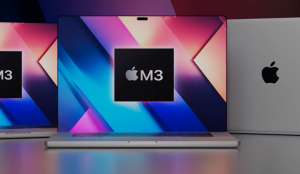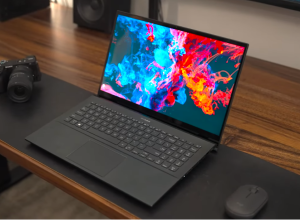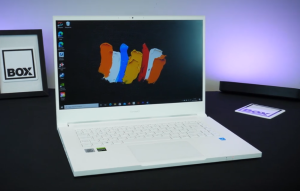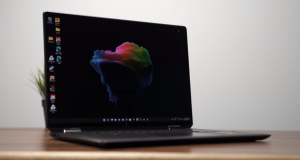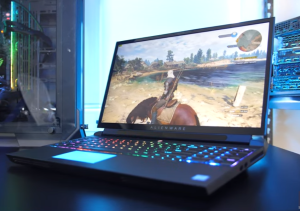Last Updated on 15/09/2023 by Dolly
This post is for you if you are into video editing and need a decent laptop to get your work done efficiently. With this discussion, we’ve compiled a comprehensive list of laptops designed exclusively for video editing in Adobe Premiere Pro software.
To render your projects smoothly in Adobe Premiere Pro video editing, you need a strong combination of GPU and CPU. Power and flexibility are required if you want to complete your work on the go. As a consequence, you must select the best laptop for your working style.
In this post, we’ll go through some computers that are ideal for video editing in Adobe Premiere Pro. Continue reading the article to learn more about it.
Powerful computers weighing only a few pounds can now execute many of the operations that editors used to undertake in a studio on complex and expensive equipment. So, whether your boss expects you to do initial cuts in the field, you’re a film student, or you simply want to examine your holiday footage on your journey home, you should consider a laptop with video editing capabilities. Here’s what you should look for.
Companies seldom produce laptops designed expressly for video editing in the same way that they do bulked-up machines for PC gaming or Chromebooks aimed at schools. As a result, you’ll have to pick and select characteristics from typical laptop categories including ultraportable, gaming laptops, and mobile workstations. Your wish list of features might wind up belonging to a fantasy machine that doesn’t quite match any laptop already on the market. But at the very least, you’ll have a starting point from which to make concessions.
Devoting the majority of your spending to a strong CPU, a beefed-up graphics card, and plenty of RAM is a safe choice, but ancillary features like storage, input/output options, and the operating system are considerably more significant to you than they are to the ordinary laptop consumer. Weight is also important because even a few extra pounds might push already hefty luggage over an airline’s weight restriction or make your carry-on too big to fit into an overhead bin.
Display specifications are especially crucial if you intend to use your laptop for more complex editing chores like shading and color correction. A comfortable keyboard is also recommended, as keyboard shortcuts assist to speed up various editing activities, such as beginning and stopping playback and inserting keyframes.
Finally, there are a few capabilities that are popular on laptops that you don’t need to be concerned with when purchasing a mobile video-editing station. The most important of them is battery life because video editing consumes so much power that your laptop will most likely spend the majority of its time plugged in. If you need to edit while on the road, bring an extra power adapter with you, and check sure your aircraft offers in-seat power outlets when you book a ticket. Unless you’re looking for a machine that you’ll use for online browsing and viewing movies after a long day of filming and editing, you won’t get much use out of a touch screen or a convertible laptop that serves as a tablet.
Display
When you wish to utilize your laptop for video editing, the display size becomes critical. For video editing, a bigger display is usually desirable. The size of your screen is proportional to the size of your workspace. Laptops with 15-inch or 16-inch displays are suggested for video editing. If you travel frequently and want a lightweight and compatible laptop, a 14-inch display will be more suitable.
CPU and Memory
The CPU and RAM are the two most significant laptop components for video editors. Most apps are designed to make use of contemporary multi-core CPUs, thus the more cores you have, the better. Multithreading, which allows each core to manage two processing threads at the same time, is also essential. To learn more about the CPU in the laptop you’re considering, visit Intel’s product directory or AMD’s Ryzen CPU product pages. Any processor you consider for serious video work should have at least four cores and multithreading capabilities for up to eight concurrent threads of processing. High-end laptop CPUs may have up to eight cores and sixteen threads. (For a more in-depth look at laptop CPUs, see our in-depth tutorial on understanding notebook CPUs.)
Check out how well the laptop you’re considering performs on our Cinebench benchmark, which is included in the performance section of each review, for a bird’s-eye view of how a greater CPU core count enhances performance. This test employs Maxon software to generate a proprietary score based on how rapidly the PC can render a 3D picture. Although a variety of factors can impact the score, the more (and faster) cores the CPU has and the more addressable threads it supports, the faster the image renders.
The same approach applies to video-editing tools such as Apple Final Cut Pro and Adobe Premiere Pro, which are designed to divide compute jobs over several cores in the same way that Cinebench is.
In general, CPUs from AMD or Intel’s power-laptop-oriented H series (search for an “H” at the end of the CPU’s model name) will be the best match for video editing. They have more addressable cores and threads, higher voltages, and occasionally faster clock rates than thin-and-light laptop competitors (the U series, which nowadays end in a “U” or “G,” with the G followed by a number). On their mobile CPUs, AMD and Intel follow the same conventions (except for the “G” in AMD’s case).
In terms of primary system memory, a decent rule of thumb is to get a laptop with 16GB of RAM. This is the maximum for many consumer ultraportables, while creator-class laptops with 32GB or more are already available. However, the cost is sometimes exorbitant, and we believe the money would be better spent on a faster CPU, therefore we’ve designated 16GB as the sweet spot.
Memory, also known as Random Access Memory (RAM), is an important consideration when selecting a laptop for video editing. Because high-quality films take up a lot of space, it is best to utilize more RAM to ensure that your project runs smoothly.
For professional video editing, a minimum of 16 Gigabytes of RAM is recommended. However, if you are a beginner or are just getting started with video editing, 8 Gigabytes of RAM would be enough.
DDR4 RAMs are a superior option, and most high-quality laptops released by Dell, HP, Apple, Asus, and others include DDR4 RAM.
Should I Buy a Video Editing Laptop with a Hard Drive or an SSD (or Both)?
To complete the trinity of primary specifications, you’ll need a fast boot drive. In almost all situations these days, this means installing a solid-state drive (SSD) in a laptop, which can retrieve data considerably faster than older spinning drives. The performance difference between an SSD and a spinning platter hard drive is significant for regular computer use because an SSD’s core talent is minimizing boot times and making software load faster. These factors are important for video editing (loading editing software might take some time if you edit under time constraints), but an SSD can still provide substantial speed benefits on specialized activities like playing back numerous clips at once or dealing with 4K material.
You should ideally have a large hard drive in addition to a fast SSD, but because the cost of built-in SSDs skyrockets at capacities above 1TB, it’s more cost-effective to ensure your laptop has a Thunderbolt 3 or Thunderbolt 4 connection to enable a link to a fast external drive where you’ll store the majority of your footage. However, some bigger workstation and gaming computers can provide two drives (an SSD boot drive and a huge platter-based hard drive), and if you’re looking for a big system, this is a perfect video editors’ setup: you have both speed and bulk storage without the inconvenience of external drives.
When it comes to evaluating SSDs, most video editing equipment has shifted toward SSDs that use the PCI Express interface (often associated with the term “NVMe,” for a protocol that affords faster data transfers than ever). These are speedier than SSDs that use the older SATA interface, which is becoming less widespread in the midrange and high-end laptops. (See our picks for the best internal SSDs.)
Video editing is a demanding endeavor that needs a powerful processor in order to complete your responsibilities smoothly. You’ll need the latest high-performance CPUs to produce your films swiftly. A higher clock speed and a greater number of cores are immediate indicators of a strong CPU.
Because all processing is eventually performed within the Central Processing Unit (CPU), a strong CPU is required for a continuous and seamless video editing experience. You may select from a wide range of CPUs on the market. Some examples are Intel Core i5/i7/i9 processors, AMD Ryzen 5/7/9 processors, and Apple’s M1 processor.
Dedicated GPU or Not for Graphics Acceleration?
Most non-gaming laptops use graphics-acceleration silicon integrated into the CPU, rather than a separate graphics processing processor (GPU). This configuration performs poorly while playing fully-featured, AAA-grade video games, but it is adequate for many video-editing tasks. Almost all video-editing packages are built to make use of faster computers, but the ability to use sophisticated graphics-processing technology is less common.
There are a couple of exceptions. A discrete GPU, for example, helps speed up the video-encoding process in Final Cut Pro X, while Blackmagic’s Davinci Resolve editing suite includes a video-playback engine tuned for fast GPUs. Still, store GPU-accelerated editing work for when you return to the studio.
However, if the laptop you’re contemplating provides an entry-level discrete GPU for a fair premium (say, $200 or so), there’s no reason not to pay for it and benefit from the extra performance advantage when exporting video. A laptop’s graphics performance may be compared by looking at its ratings on our 3DMark benchmark tests. Some laptops include an integrated graphics card as part of the motherboard. Purchasing laptops with integrated graphics cards are not advised. Video editing in Adobe Premiere Pro necessitates the use of specialist graphics cards.
Almost all professional video editors edit their films on high-quality graphics cards. Even if you are new to video editing, it is suggested that you spend some additional money on a powerful GPU because it is a one-time investment. The better one you acquire, the more smoothly your project will be completed.
Nvidia is the most well-known manufacturer of graphics cards. The firm develops powerful graphics cards that facilitate video editing. They make strong GPUs such as the Nvidia GeForce GTX and RTX. Aside from Nvidia, AMD Radeon Pro is a fantastic alternative to consider.
What Ports Should I Look for in a Video Editing Laptop?
You don’t want to add weight to your luggage if you’re already hauling dozens of pounds of camera and lighting gear. Fortunately, many powerful computers now weigh less than 3 pounds. The thinnest and lightest will lack discrete GPUs and displays bigger than 14 inches, but you may be able to live without these capabilities, especially if you have a studio with a more powerful editing station where you perform the most of your cutting.
However, if you’re trying to reduce weight, try not to drop too many ports. We recommend at least one Thunderbolt port, which allows you to connect to external displays through the DisplayPort standard, lightning-fast external storage, and virtually any USB connection, such as external mice or keyboards, with the proper cable or an adapter. (Thunderbolt 3 or 4 ports are electrically and physically compatible with USB Type-C ports.) Some computers, such as all MacBook Pro models, only have Thunderbolt 3 connectors. One or two Thunderbolt ports plus one or two standard USB 3.0 or USB 3.1 ports are ideal.
A full-size SD card slot is also essential for instantly downloading a film from your camera to your laptop, and all computers should include an audio jack for connecting headphones to use when editing on the aircraft or in a cafe.
What is the optimal screen size for a video editing laptop?
With the majority of mainstream and higher-end laptops now having at least full HD (1,920-by-1,080-pixel) resolution, your primary screen concern should be screen size rather than pixel count. A 15-inch or 17-inch monitor will allow you to view more of your project schedule, but it will be heavier and bulkier. Meanwhile, a 12-inch display may cause you to squint.
If you need to travel with your editing machine, the sweet spot is 13 or 14 inches. By slimming down the bezel, or border, around the screen, many laptops can fit a 13-inch or 14-inch screen into a chassis that would normally support a smaller display. But take note: most laptops with this screen size will default to a U-series CPU. The most powerful CPUs are often found in 15-inch and bigger versions. This is due to the fact that the larger the laptop, the more thermal leeway the designer has to include more powerful components.
While full HD resolution is adequate for many editing operations, if you film predominantly in 4K, you’ll need a screen with the same resolution. When you combine a 4K (or 3,840-by-2,160-pixel) screen, a six- or eight-core processor, plus a discrete GPU, you’re going to get a fairly short battery life. So, if you decide on a 4K screen, be sure you’ll be able to keep it near a power outlet most of the time and consider purchasing an extra battery charger to use in an emergency.
On the opposite end of the scale, never use video-editing equipment with a resolution less than full HD (such as 1,366 by 768 pixels). However, new laptops with displays that are less than full HD are unusual, save in the most affordable models.
If the majority of your video-editing chores consist of organizing clips, mixing audio, and the like, you generally don’t need to be concerned with the display’s color capabilities. However, for more creative or precise operations, such as shading and color correction, you should consider how many colors the screen can display and how it calibrates the color profile. Look for DCI-P3 or Adobe RGB color-gamut compatibility, as well as automated calibration, which is sometimes combined into a single marketing name, such as HP’s DreamColor. OLED panels and those with HDR capabilities provide more color contrast and may be useful as well. (See our picks for the best OLED-screen laptops thus far.)
As previously said, you probably don’t need to be concerned about whether or not the laptop has a touch screen. Precision and repetition are required for video editing, which is ideally suited to keyboard shortcuts and a mouse rather than touch inputs. The MacBook Pro’s Touch Bar, a small, secondary touch panel sitting ahead of the keyboard, between it and the screen, is the sole exception. It’s intended for products like Final Cut Pro and the Adobe Creative Suite, and it will display context-sensitive shortcuts to approved software. It’s simply a function row for serious content makers that changes depending on the application being used.
Mac or PC?
Video editors are among the creative professions who, stereotypically, choose Macs over PCs. Whether or whether you match that stereotype, if you’re an industry veteran, you undoubtedly already have a preference, so we won’t try to sway your opinion.
If you don’t care about the operating system, you have a wide range of hardware options if you pick a PC laptop over a Mac laptop. The most significant advantage of using Windows or Linux is the ability to purchase a workstation-class laptop with a multi-core Intel Xeon CPU, which is not accessible on any Mac portable.
Another factor to consider is your preferred video-editing program. Final Cut Pro, for example, is exclusively accessible on Macs, but most other editing suites, from Premiere Pro to Avid Media Composer, are available on various platforms. If you’re committed to certain software, we’d expect that to influence your selection just as much as, if not more than, the operating system or the hardware available.
What Laptop Should I Purchase for Video Editing?
We’ve compiled a list of our favorite models for video editing. Some are aimed at content makers, while others are mobile workstations. A handful is genuinely thin-and-light versions. Any of these should be powerful enough for light editing, while several are powerful enough for heavy editing.
Finally, how much you’ll have to budget depends on whether you want to carry your video-editing laptop back to the studio, plug it in, and use it as your primary machine. If you choose the former option, you should also look at our best desktops when it comes time to update your primary rig. If you go for the latter, you might want to check out our list of the best gaming laptops, since one of them might have the power—especially the beefier CPU—you need for marathon editing sessions on deadline night. Color-accurate displays are not their strong suit, but excellent gaming laptops have many of the same characteristics as a good video editing laptop.
One of the most important decisions you’ll have to make when purchasing a laptop for video editing is whether to obtain a MacBook or a laptop that runs Windows 10. (or Windows 11).
Part of this is down to personal preference. If you’re used to Windows operating systems, you might find macOS, which is what MacBooks operate on, a little strange in terms of how things work – and vice versa.
Both Windows and macOS, however, provide essentially the same video editing software packages. Final Cut Pro, on the other hand, is a popular program that is exclusively available for MacBooks.
MacBooks are popular among video editors because of their strong performance and elegant looks, although in recent years, Windows laptops such as the Dell XPS series have easily matched Apple’s laptops in both beauty and substance.
Windows laptops also benefit from a diverse choice of manufacturers, so if you don’t like the style of one brand’s laptop, you can always choose another. Only Apple manufactures MacBooks, so if you want one but don’t like Apple’s design, you’re out of luck.
Top 10 Best Laptops for Adobe Premiere
1. Microsoft Surface Book
Microsoft Surface Book is the company’s most recent laptop. This laptop is available with an Intel Core i5 CPU from the 10th generation. The RAM capacity is 8 gigabytes. There are 128 gigabytes of SSD storage available. It is also possible to upgrade to a 256 GB version. It has a long battery life of around 10 hours.
The Microsoft Surface Book is most suited for mobile employees, although it can also be used as a tablet. The elegant ergonomic design is ideal for your work ethic. Upgrade to Windows 11 is also available for free.
Best Features:
- Lightweight
- Upgradable to Windows 11
- Fast charging
- Latest Processor Chip
- Can also be used as a tablet
- Long Battery Life
2. Dell XPS 15
The Dell XPS 15 is a high-performance notebook. The CPU is an Intel Core i7 10th generation. The massive 16 gigabytes of DDR4 RAM is more than enough to complete all of your tasks in one go. There is also a dedicated graphics card included. Because of the 4 GB Nvidia GeForce GTX 1650, it’s an excellent choice for video editing in Adobe Premiere Pro.
The display is 15.6 inches in size, which is ideal for light packers. Colors are vibrant and precise on the 4k+ display. When used for extended periods of time, the sophisticated thermal system keeps the laptop cool. The improved sound quality creates a 3D sound experience. The screen of the XPS 15 is protected by Corning Gorilla Glass 6, which makes it scratch-resistant.
Best Features:
- Damage resistant and Durable
- Dedicated graphics card
- Extraordinary display
- Available in both Intel and AMD processor variants
- Superb speaker quality
- Large trackpad for smooth usage
3. Apple MacBook Pro
The Apple MacBook Pro is the company’s most powerful notebook. The most basic MacBook Pro model starts with 16 GB of RAM, which may be upgraded to 64 GB. A total of 1 TB of storage space is given. This is one of the most powerful laptops on the market, powered by an Intel Core i9 processor. The 16-inch Retina display is unique. This machine gives a realistic video editing experience. The 8-core CPU distributes all of your workloads smoothly, giving you the finest possible experience.
This laptop includes AMD Radeon Pro 5000M series graphics. This results in extremely smooth video rendering. The scissor mechanism is used by the magic keyboard, and the touch bar is incredibly responsive. All of this comes with impressive 11-hour battery life. This laptop is ideal if you travel frequently and need to complete work on the fly. If you already possess an Apple product and want to upgrade it, this is the best option for you.
Best Features:
- Apple T2 Security Chip
- Flabbergasting Retina Display
- Powerful processor and graphics
- Fantastic keyboard
- Comes with Apple Softwares
- Extremely Long battery life
4. Lenovo ThinkPad X1 Extreme
The Lenovo ThinkPad X1 Extreme has a 15.6-inch ultra-high-definition 4K display that is 3rd Generation. The built-in processor is an Intel Core i7 10th Generation. This laptop includes Windows 10 Pro in 64-bit architecture. The storage capacity is 1 TB of SSD. The included graphics card is an Nvidia GTX 1650, which is adequate for video editing.
This laptop is powered by 16 GB DDR4 RAM. There are several connectors, including two USB-C Thunderbolt ports. SIM tray, HDMI 2.0 port, SD Card Reader and USB 3.2 Gen 1 connectors This laptop is ideal for a variety of climates and is resistant to heat and humidity. If you live in harsh areas, the ThinkPad X1 Extreme is the best laptop for you.
Best Features :
- Dedicated graphics card
- Latest Processor
- Durable
- Comes with Windows 10
- 4k UHD Display
- Large storage
5. Asus ZenBook Pro
The Asus ZenBook Pro is a multimedia-focused ultrabook. It has a 15.6-inch Ultra High Definition NanoEdge touch screen. The ScreenPad Plus is an excellent camera and video editing tool. It is beneficial to include tools, references, and source files in order to see and accomplish more.
The given CPU is an Intel Core i7. In addition, there is 16 GB DDR4 RAM. The storage is quick, using a PCIe NVMe 1 TB Solid State Drive. A powerful graphics card — the Nvidia GeForce ETX 2060 – is included. Windows 10 Pro comes with the operating system pre-installed.
Best Features:
- Lightweight
- ScreenPad Plus
- UHD OLED NanoEdge Display
- Powerful ultrabook
- Back-lit keyboards
- Advances graphics card
6. Acer ConceptD 3 Pro
The Acer ConceptD 3 Pro is a laptop that can be converted into a tablet. It has an Intel Core i7 CPU from the 10th generation. The 14-inch display is covered by Gorilla Glass. The combination of a 16 GB NVMe Solid State Drive and an Nvidia GeForce GTX 1650 allows you to render your projects quicker. There is 16GB DDR4 RAM installed on the motherboard.
The Intel Wireless WiFi 6 provides excellent wireless connectivity. As a stylus, a Wacom AES 1.0 Pen is included. The keyboard employs scissor technology, and specific creator hotkeys are supplied. This foldable laptop can create high-quality films in a matter of seconds. Furthermore, the fact that it is foldable makes it easy to use.
Best Features:
- Foldable laptop
- Light and Durable
- Optimized thermal cooling
- WiFI 6
- Keyboard Design
- Touchscreen and Stylus available
7. HP Spectre x360
The HP Spectre x360 is a laptop with an Ultra High Definition Touch Screen. It is powered by an Intel Core i7 processor and includes a 512 GB PCle NVMe MSolid State Drive. There is a total of 16GB DDR4 RAM available. The front camera is a Full High Definition Wide Vision Infrared Camera. It is aided by a dual array digital microphone. The keyboard is backlit, and a stylus is included. Thunderbolt 3, USB 3.1 Type C, and HDMI connectors for seamless communication.
This laptop has a dedicated 2 GB Nvidia GeForce MX150 graphics card. The touch screen makes it exceedingly easy to use the Adobe Suites, particularly Adobe Premiere Pro. Editing with a stylus greatly enhances productivity.
Best Features:
- Touch Screen
- Comes with Windows 10 Operating System
- Dedicated graphics card
- Light-weight
- Powerful processor
- Durable Design
8. MSI GF65
The MSI GF65 has a cutting-edge 6 GB graphics card, the Nvidia GeForce RTX3060 Max. In addition, it is powered by two 8 GB DDR4 RAMs split over two sockets, totaling a whopping 16 GB RAM. The screen has a 15.6-inch display with a very fast refresh rate. it is ideal for multimedia applications
This laptop includes Windows 10 preloaded. The SSD is 512 GB NVMe. Bluetooth and WiFi wireless communication is available. The laptop is a little hefty, but it is quite powerful and well-suited for long-term video editing in Adobe Premiere Pro.
Best Features:
- Mammoth graphics of 6GB
- Back-lit Keyboard
- Powerful Processor
- Good build quality
- High refresh rate screen
- Good audio quality
9. Alienware Area 51m
The Alienware Area 51M is a gaming laptop at its core. It has a 1 TB SSD and 16 GB of DDR4 RAM. This beast is powered by an Intel Core i7 processor from the 10th generation. This laptop is also available with the AMD CPU. This laptop is equipped with a strong dedicated graphics card. Because the 8GB Nvidia GeForce RTX 2070 Super is better suited for gaming, it can do all multimedia chores including video editing in Adobe Premiere Pro with ease. It includes a 2.5Gbps ethernet connection and increased storage capacity of up to 1 TB.
This laptop’s lethal mix of CPU and GPU is well suited to doing heavy computation jobs in a short amount of time. The Thunderbolt Type-C interface allows for extremely rapid data transfer. The 17.3-inch screen is enormous and really useful when working with Adobe Suits and Adobe Premiere Pro.
Best Features:
- Dedicated 8GB Graphics
- 10th Gen Intel i7
- 16GB RAM
- Large screen for easier work
- Back-lit durable keypad
- Fast Connectivity
10. MacBook Air
Apple’s MacBook Air is an evergreen product. It is currently the most popular Apple laptop. If you are a college student or have a limited budget, Air is the ideal alternative for you. The MacBook Air is a small, lightweight notebook that is ideal for everyday use. Despite its modest technological characteristics, the MacBook Air outperforms several decent computers that are much more expensive. It has 256 GB of SSD storage as well as 8 GB of DDR4 RAM.
The Intel Core i5 CPU from the 10th generation is quite powerful enough to tackle all of your work. If you are new to video editing and want to become acquainted with the Apple community, the MacBook Air is ideal. It has a 13.4-inch screen, which is large enough to tackle modest to medium-sized tasks. It is lightweight and quick to process, making it ideal for first-time users.
Best Features:
- Extremely light-weight
- Pocket friendly
- Great battery life
- Comes in many vibrant colors
- High-resolution Retina display
- Suited for all purposes
Conclusion
We hope you found this post useful. Our selection of the best laptops for Adobe Premiere Pro includes some of the most powerful as well as the most affordable laptops for the job.
you may like these:-



